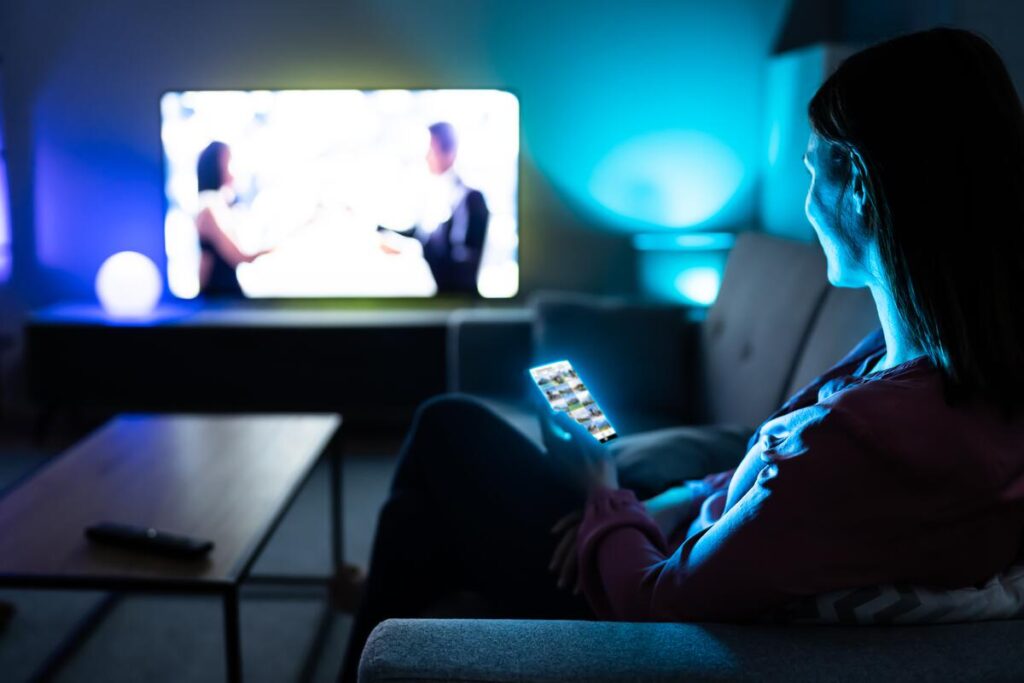Do LED TVs Burn Out? (Explained)
Disclosure: Tech Parasol is supported by its readers. When you purchase through links on our site, we may earn an affiliate commission. Thank you.
- LED TVs do not contain incandescent bulbs and do not “burn out”.
- The LEDs in the TVs backlight can become defective which can severely affect the picture.
- The LEDs in a TV should last for at least 50,000 hours at maximum brightness with continuous usage.
LED TVs are simply LCD TVs with LED backlights.
They need an LED backlight because the pixels in an LCD TV are transmissive and are unable to light up by themselves.
But, how reliable are they, and do they burn out?
Here’s what you need to know about LED TV burn out:
LED TVs do not “burn out” because they don’t contain incandescent bulbs that contain metal filaments. LED TVs do however have strips of LEDs that can sometimes become defective resulting in either a black screen, a flickering screen or a screen that shows black or light spots.

The LEDs in the TVs backlight are instead made out of semiconductors which produce light when a voltage is applied and as an electrical current flows through them.
Although LEDs can’t burn out as such, they can become defective severely affecting the quality of the picture.
Here are some things to look out for:
LED TV backlight failure symptoms
If an LED backlight fails or partially fails, then it’s likely that you will notice one or more of the following symptoms:
Black screen
In this case the TV is on and is producing images, but because the backlight is broken and not illuminating the screen, you won’t actually see them.
Instead you will see darkness but you may still hear the audio.
Dim screen
A dim screen could be the result of the brightness and/or contrast settings being turned down on your TV. But equally, it could be a result of one or more defective LEDs.
Flickering screen
A dying backlight can cause the screen to flicker on and off. But it may not be the only cause.
It’s also worth checking the power cable and/or other cables attached to your TV to see if a break in any one of these cables is causing the issue.
Dark spots
This can happen when some of the LEDs are broken whilst the others are working normally.
This usually happens when LEDs are still conducting electricity despite not producing any light.
Light spots
Light spots on the screen can occur when the lens falls down from the LED strips.
It’s sometimes possible to see the lens at the bottom of the screen and you can often hear them rattling around if you move the TV.
Half bright screen
This happens in edge-lit displays when the LEDs fail on one side. This causes the screen to be bright on one side and dark on the other.
This can happen either left to right or top to bottom depending on the location of the LEDs.
Blue light
If your screen turns blue then this is a result of the LEDs producing blue light instead of white light.
Bleeding lights
This causes similar symptoms to the half bright screen symptoms mentioned above.
In this scenario, the light is not distributed evenly on the screen and is caused by one or more of the LED strips moving out of place.
What causes LED backlight failure?
Here are some of the main causes of LED backlight failure:
Power surges
Power surges can cause damage to electronic components in the regulator circuit such as rectifier diodes and electrolytic capacitors.
This can prevent power getting to the LCD panel.
Defective LEDs
The LED strips in an LED backlight are wired in series.
This means that a single defective LED can cause an open circuit causing all the other LEDs to be extinguished.
The result is a very dim screen that can only be viewed in a dark room.
Sometimes, LEDs that are damaged can still conduct electricity, even though they don’t produce any light.
This can result in dark spots on the screen.
LED driving circuit
Another reason for backlight failure is the failure of the LED driving circuit. If the driver circuit fails to supply the correct voltage and current to the LEDs, then this can kill the LEDs.
Power supply
A power supply failure will also prevent the LEDs from turning on.
Does increasing the backlight brightness cause LEDs to burn out?
Increasing the brightness of the LED backlight won’t cause the LEDs to burn out.
But increasing the brightness of LEDs in general increases the temperature of the LED.
This can reduce their lifespan and the amount of light that they produce will reduce over time.
That being said, if too much voltage is applied to an LED or if too much current flows through it, then that will kill an LED.
But this is highly unlikely to happen in a TV unless something happens in the LED driver circuit to cause an increase in voltage/current to the LEDs.
Does HDR cause LEDs to burn out?
HDR requires a TV to get bright (about 600 nits) to properly produce HDR content.
But HDR in itself does not cause LEDs to burn out.
Can LED backlights be replaced?
Yes, LED backlights can be replaced.
But unless you know what you’re doing, you should get this done by a professional, as it involves disassembling and reassembling the TV in order to replace the LED strips.
You also need the correct LEDs for your TV.
You should also consider the cost of doing the repair. If your TV was inexpensive, then it may not be worth the cost.
Does LED burnout cause dead pixels?
LED burn out does not cause dead pixels. Rather, LEDs that stop working and dead pixels are two different things.
Dead pixels are when the all three RGB (red, green, blue) sub-pixels are permanently turned off in a liquid crystal display.
This causes tiny black spots to appear on the display.
These are often caused by malfunctioning transistors failing to supply power to the pixel or by manufacturing flaws.
Malfunctioning LEDs are different.
If the LEDs in the LED TV backlight stop working, then this will also cause dark areas to appear on the screen in the areas where the dead LEDs are.
In this situation, the pixels themselves in the liquid crystal layer of the TV can still be functioning normally.
Do QLED TVs burn out?
The LEDs in a QLED TV are the same as the LEDs in “normal” LED TVs and don’t “burn out”.
Although QLED TVs have a layer of quantum dots applied to the screen to enhance colors and image brightness, they still rely on an LED backlight for the illumination of the pixels.
And although the LEDs don’t “burn out”, they do produce less light over time.
The LED strips at the back of the TV can become defective resulting in one or more LEDs failing to turn on.
Do LEDs in TVs get hot?
The LEDs in an LED TV backlight can get warm during normal operation, but not hot.
That is unless one or more of the LEDs become defective, in which case, they can produce a lot of heat.
How long do the LEDs last in TVs?
As a rough guide, most LEDs have a lifespan of between 50,000 and 60,000 hours.
This is between 5.7 years and 6.8 years of constant use.
Assuming you don’t watch TV 24/7, then the LEDs should last even longer, even at maximum brightness!
In comparison, LEDs last about 50 times longer than a typical incandescent bulb.
But LEDs do not fail by “burning out” like incandescent bulbs do. Rather, the light output that they produce will slowly reduce over time.
LEDs are solid state devices which use semiconductors to produce light and they can continue to operate after 100,000 hours have passed.
As such there is no standard definition for LED lamp life.
Instead, the lifespan of LEDs is the time at which the light output falls to a certain level.
The formats that are used in the industry are L70 or L50.
These formats tell us the LED life expectancy when the light reduces to 70% or 50% of its initial value respectively.
How long do LED TVs last?
One of the first parts to break in an LED TV are the LEDs themselves.
These can last 50,000 hours or longer depending on how often the TV is used and how close the backlight is to maximum brightness.
But 50,000 hours is 5.7 years of constant use (24/7) and at maximum brightness.
This lifespan number also indicates when the LED degrades to half-brightness and not when the LED itself stops working completely.
So an LED TV will typically last much longer assuming the TV isn’t constantly switched on!
Sources
LED Lifespan: Light Emitting Diode MTBF Lifetime » Electronics Notes
What is the life of LEDs? | LED Lighting Systems | Lighting Answers | NLPIP
What is dead pixel? – Definition from WhatIs.com
The truth about LED lifetime — and the longevity of your display

Robert Anderson
Robert Anderson, the founder of Tech Parasol, had a keen interest in tech from a very young age. He studied Electronic Engineering at University and then went on to become a Software Developer. He launched Tech Parasol in 2021 to share his knowledge with the aim of making tech easier to understand for everyone.

